The State of Decarbonization 2025
Executive Summary
As we enter 2025, organizations around the globe face increasing pressure to meet their climate commitments. With reporting deadlines fast approaching, businesses and institutions are being forced to evaluate their progress and recalibrate their strategies.
But how are we doing when it comes to decarbonization?
EnergyCAP, a leading energy and sustainability software platform, surveyed 114 energy and sustainability leaders across sectors such as higher education, government, retail, and other commercial industries to better understand the state of decarbonization. This eBook distills the key findings from the survey and explores how organizations are faring in their efforts to transition toward more sustainable operations.
In this report, we dive into the major trends shaping the decarbonization landscape as organizations set ambitious sustainability goals. Key findings include:
- 62% of organizations have defined decarbonization goals—more than one-third of these have set specific target dates.
- The average ESG team size is six members, with 37% of organizations reporting 10 or more individuals involved.
- Scope 1 and 2 emissions tracking is nearly universal, but fewer than a quarter of organizations fully engage with their Scope 3 data.
- Energy efficiency and electrification are top organizational priorities, while carbon offsets rank at the bottom.
- Access to relevant and accurate data and goal setting were cited as the biggest challenges to decarbonization.
Methodology
The State of Decarbonization survey was conducted to better understand and assess the maturity scale of decarbonization efforts. Written responses from the survey were transcribed as-is into this eBook to maintain authenticity.
Decarbonization goals: A defining moment
According to our survey, 62% of organizations have defined decarbonization goals, with over one-third committing to specific deadlines. However, there is still a notable 38% of organizations that are lagging in formalizing their climate targets. This divergence highlights a critical need for leadership, planning, and accountability in sustainability efforts.
For those that have set specific goals, 2025 is a pivotal moment as they transition from planning to execution. Organizations are now evaluating not only how to meet these goals, but also how to exceed them for long-term viability.
Compared to last year’s survey, goals have increased by 7 percentage points—proving that more organizations are joining the decarbonization movement.
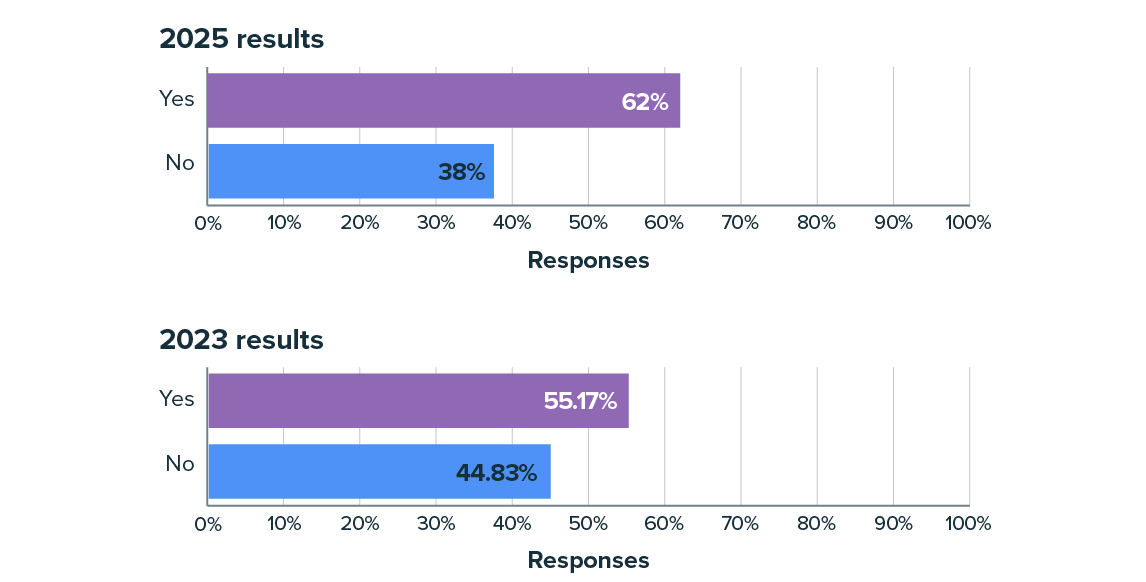
Let’s do it together! More people are getting involved in ESG.
The average organization employs six people in its ESG (Environmental, Social, Governance) efforts. 37% of respondents report having 10 or more people involved, emphasizing the need for cross-functional collaboration.
However, with organizations varying in size and resources, the number of personnel dedicated to sustainability can range dramatically. This disparity can be seen as both a challenge and an opportunity—while some organizations struggle to allocate enough manpower, others are capitalizing on larger teams to drive more comprehensive strategies.
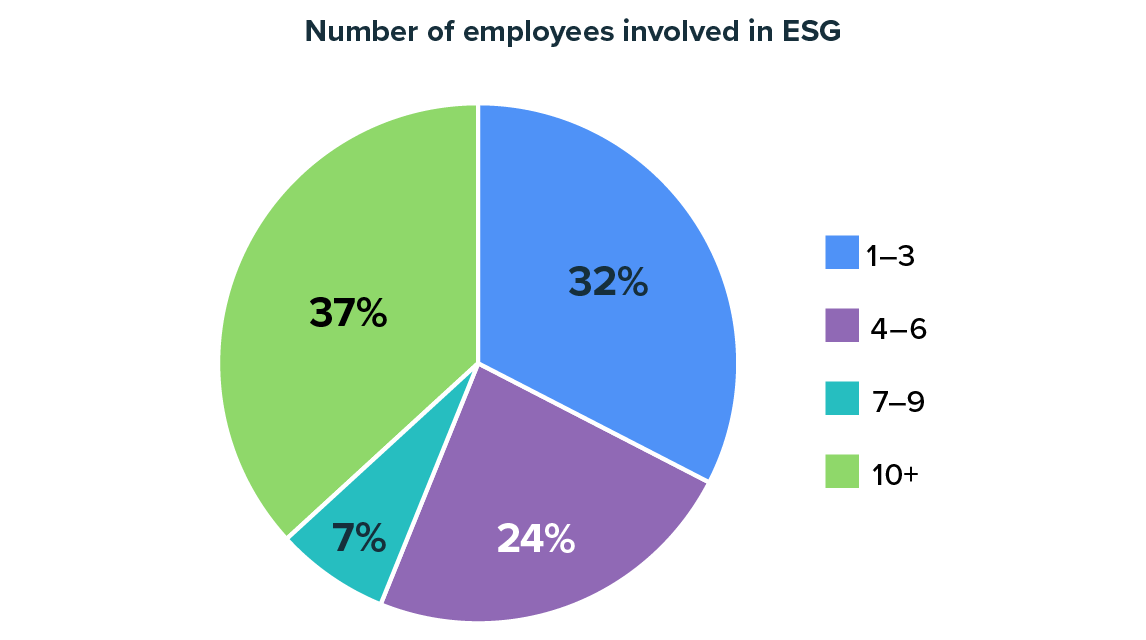
Why decarbonize? Long-term viability and regulatory pressure
More than half of the survey respondents indicated that long-term viability and regulatory compliance were the primary drivers for decarbonization efforts. Only about one-third of organizations pursued GHG (greenhouse gas) reduction as a result of executive initiatives. This finding underscores the evolving nature of climate action, where regulatory mandates and market forces are more powerful than executive-driven sustainability agendas.
As organizations navigate a rapidly changing regulatory landscape, the ability to adapt their decarbonization strategies will become even more crucial.
Compared to last year’s report, most priorities remained except for "Reputational risk", which rose above "Altruistic organizational initiative". This is an expected shift with an increase in investor involvement.
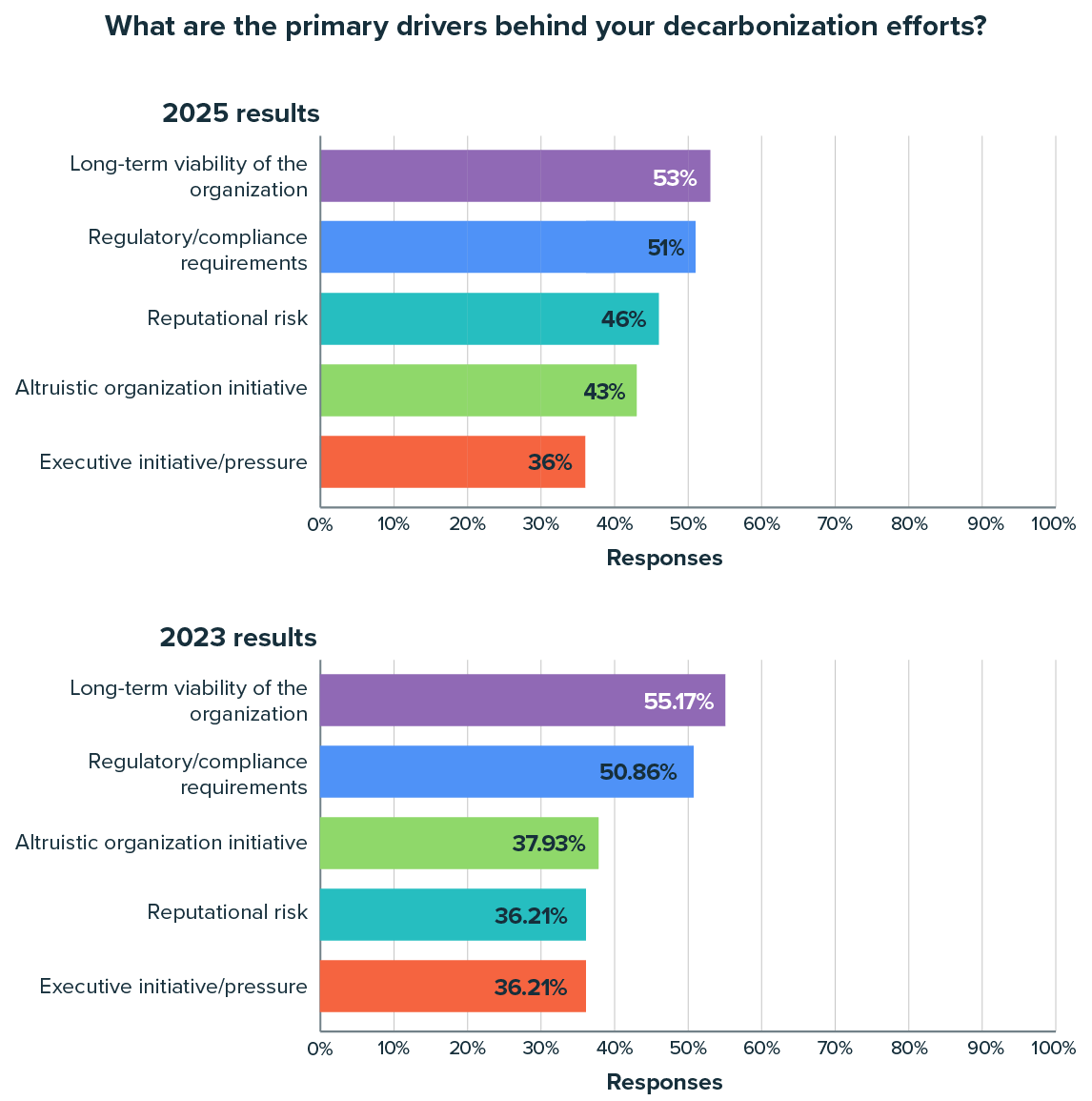
Scope 1 and 2 emissions are nearly universal! Scope 3 on the horizon…
While 68% of organizations are tracking and reporting at least Scope 1 and 2 emissions, the complexities of Scope 3 (indirect emissions from the supply chain and other external factors) remain a significant challenge. Only one-quarter of respondents are fully tracking Scope 3 data, and just over one-third are even engaging with their suppliers on this issue.
Scope 1 and 2 tracking
- 68% track direct (Scope 1) and energy-based (Scope 2) emissions
- Over 53% track major energy usage
Scope 3: The next frontier
- Only 24% track all applicable Scope 3 emissions
- 34% are engaging upstream and downstream partners
This disparity in tracking capabilities suggests that while most organizations have a firm grasp on direct emissions, there remains a substantial gap in addressing the full spectrum of their carbon footprints.
Compared to last year’s results, we’ve seen a significant increase in the percentage of respondents tracking Scope 1 and 2 (22 percentage points) AND tracking major energy usage (11 percentage points). While Scope 3 still trends down on the prioritization list, we see a year-over-year increase in people tracking select Scope 3 emissions and a 23 percentage point increase in respondents tracking all applicable Scope 3 emissions categories. Scope 3 reporting is growing in importance, and we expect to continue to see this trend upward in years to come.
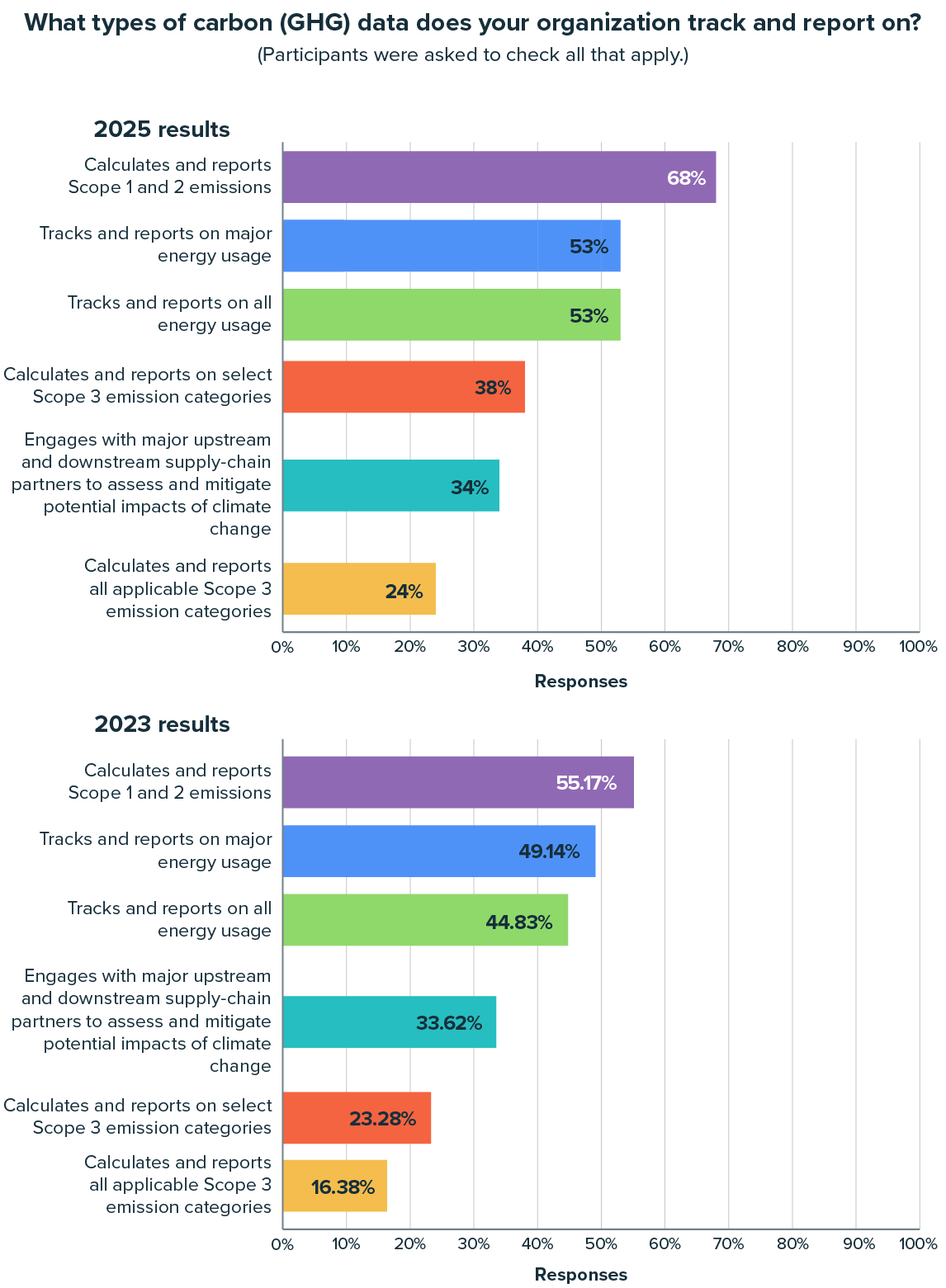
Priorities in decarbonization: Energy efficiency reigns supreme
When asked to rank their decarbonization priorities, energy efficiency improvements emerged as the top focus, with 90% of organizations placing it in their top three priorities. Electrification also ranked high, with 70% of respondents listing it among their primary objectives.
Conversely, carbon offsets ranked low, with only 6% of respondents viewing them as a priority. This suggests that most organizations are seeking long-term, tangible improvements in their operations rather than relying on offset mechanisms.
Hierarchy of sustainability priorities:
- Energy efficiency
- Electrification
- Carbon offsets (ranked last by most)
This data suggests a clear trend: organizations are prioritizing improvements that can drive direct, measurable reductions in emissions over the more abstract and often controversial concept of carbon offsets.
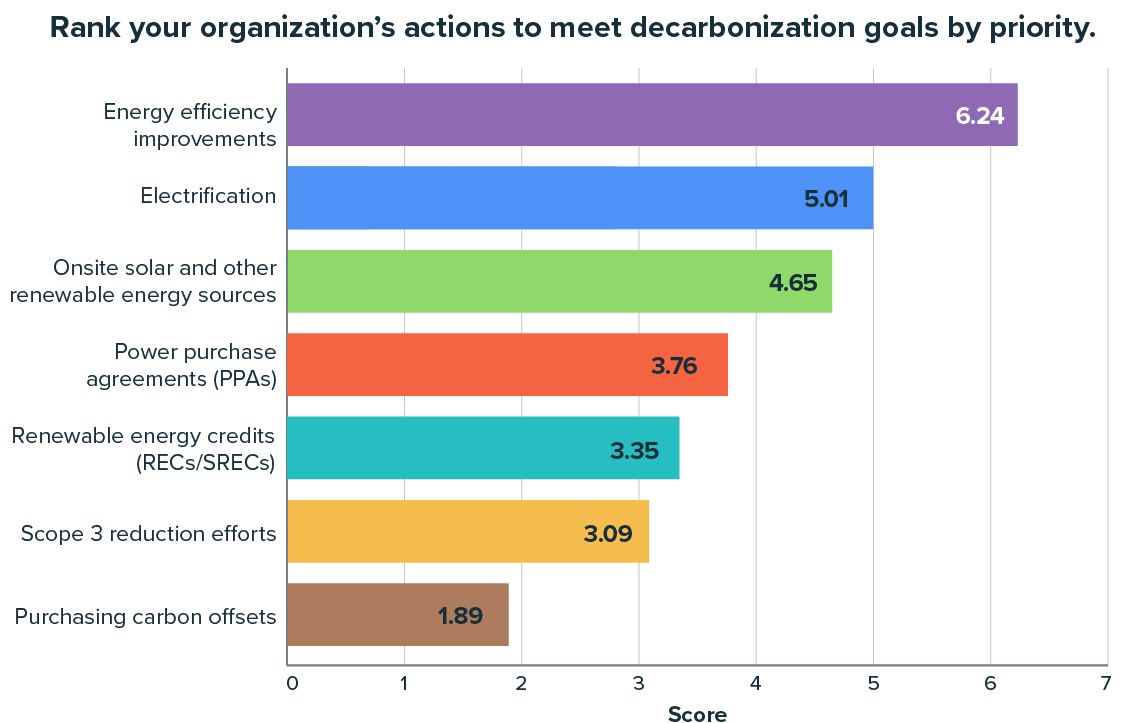
Challenges: Data and budget constraints
The two biggest challenges identified by respondents were access to relevant and accurate emissions data, as well as setting realistic goals. This data limitation presents a significant hurdle, as organizations that fail to capture the full scope of their emissions may fall short of their decarbonization targets.
Additionally, budgeting for decarbonization tools and programs remains a polarizing issue. Interestingly, 27% of respondents ranked budget constraints as their biggest challenge, while the same percentage ranked it as the least challenging. This divide suggests that for some organizations, financial resources are a major limiting factor, while others have already allocated sufficient funds to their decarbonization efforts.
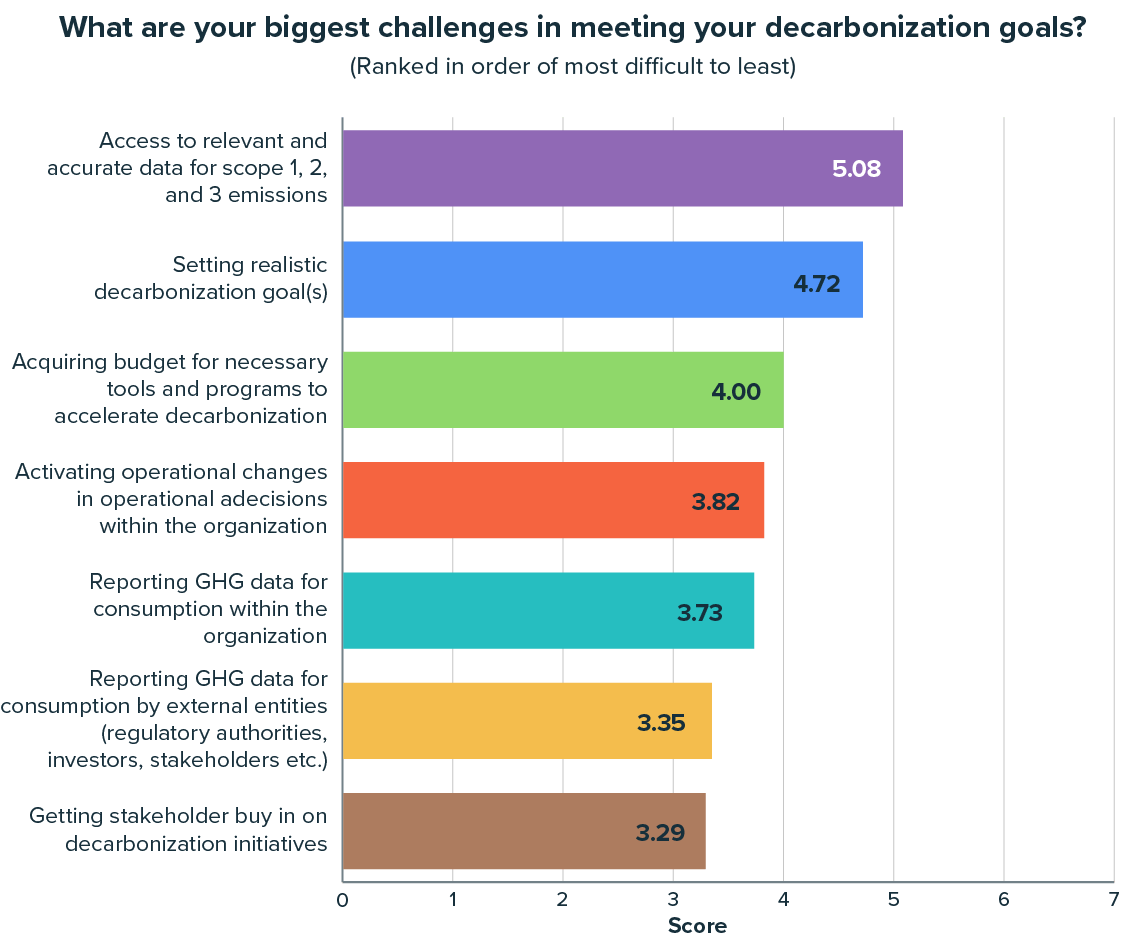
Data collection: The struggle for automation
Most organizations are still relying on manual processes for data collection, with annual manual data gathering being the most common approach. The shift toward more automated and real-time data collection is still in its infancy, with only a small fraction of organizations adopting these advanced methods.
Here’s a breakdown of current data collection practices:
- Manual data collection (annual): 1 in 1
- Manual data collection (monthly): 1 in 2
- Semi-automated data collection (annual): 1 in 2
- Semi-automated data collection (monthly): 1 in 3
- Real-time data collection: 1 in 20
This data suggests there’s ample opportunity for innovation in the automation of sustainability reporting, a key area for future investment and improvement.
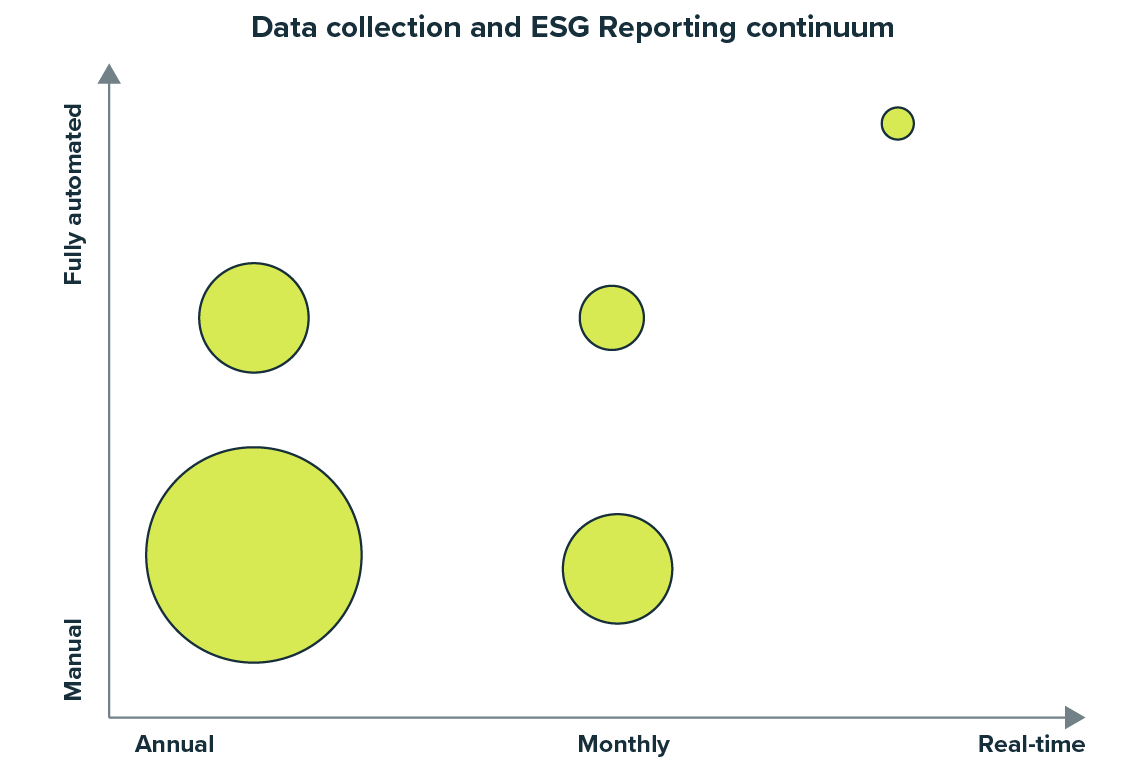
![]()
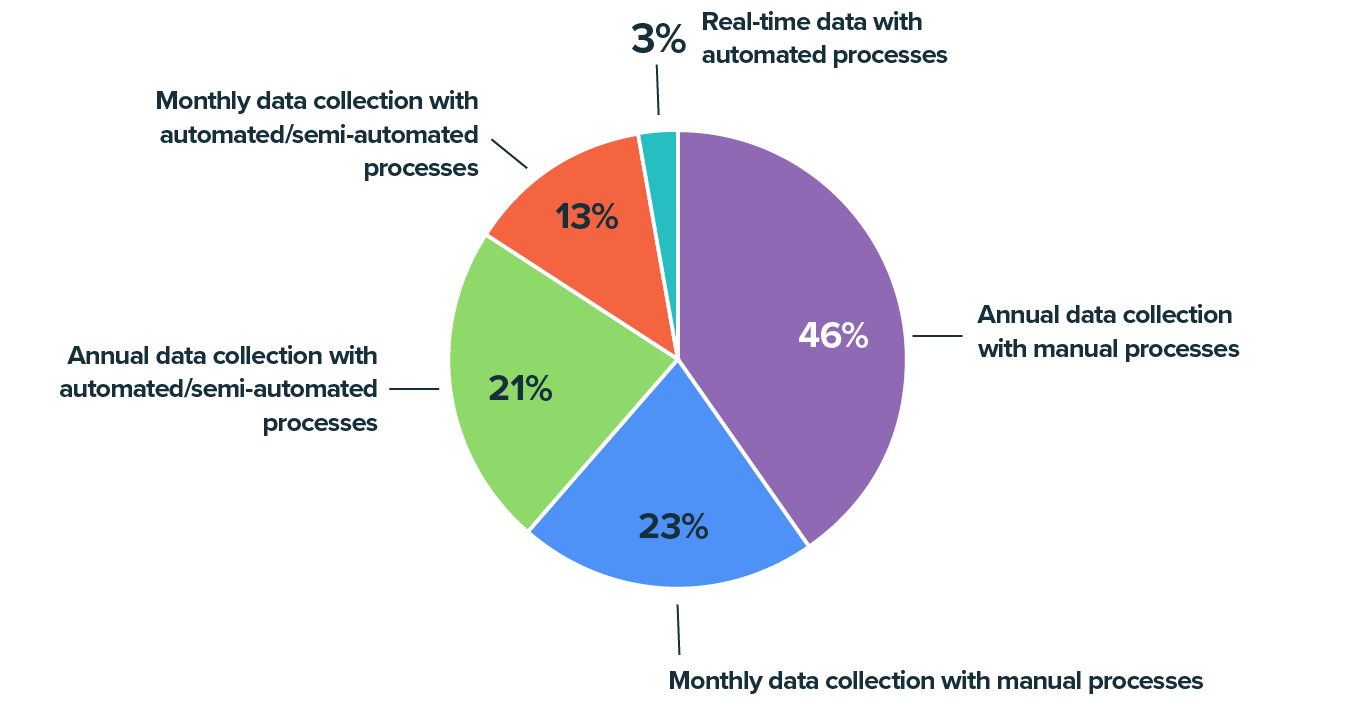
Conclusion: The path ahead
The journey toward decarbonization is well underway, but challenges remain. Access to accurate emissions data, regulatory compliance, and financial constraints all pose significant barriers. However, with growing commitments to energy efficiency and electrification, organizations are clearly prioritizing long-term, impactful actions.
As we look toward the future, the importance of collaboration, innovation, and accountability will only increase. Organizations must continue to build robust ESG teams, embrace automation, and engage their supply chains to fully capture the scope of their emissions. By doing so, they will be better positioned to meet—and exceed—their decarbonization goals.
 Best-in-class portfolio-level energy and utility bill data management and reporting.
Best-in-class portfolio-level energy and utility bill data management and reporting.
 Real-time energy and sustainability analytics for high-performance, net-zero buildings.
Real-time energy and sustainability analytics for high-performance, net-zero buildings.
 A holistic view of financial-grade scope 1, 2, and 3 carbon emissions data across your entire business.
A holistic view of financial-grade scope 1, 2, and 3 carbon emissions data across your entire business.
 Energy and sustainability benchmarking compliance software designed for utilities.
Energy and sustainability benchmarking compliance software designed for utilities.










